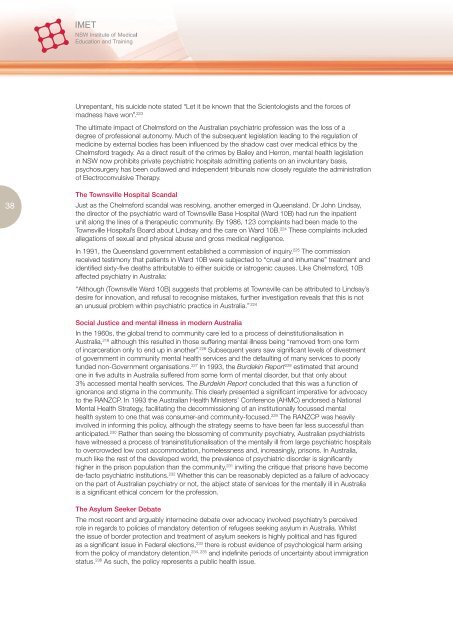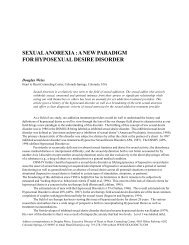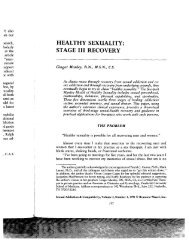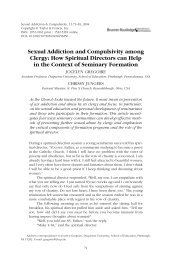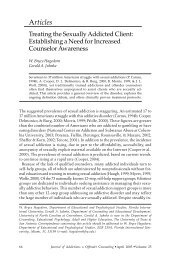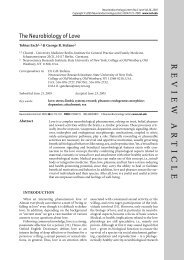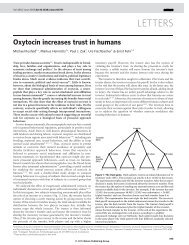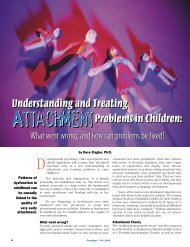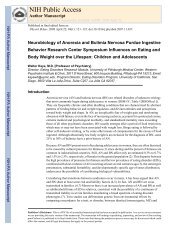An Overview of Psychiatric Ethics
An Overview of Psychiatric Ethics
An Overview of Psychiatric Ethics
Create successful ePaper yourself
Turn your PDF publications into a flip-book with our unique Google optimized e-Paper software.
Unrepentant, his suicide note stated “Let it be known that the Scientologists and the forces <strong>of</strong>madness have won”. 223The ultimate impact <strong>of</strong> Chelmsford on the Australian psychiatric pr<strong>of</strong>ession was the loss <strong>of</strong> adegree <strong>of</strong> pr<strong>of</strong>essional autonomy. Much <strong>of</strong> the subsequent legislation leading to the regulation <strong>of</strong>medicine by external bodies has been influenced by the shadow cast over medical ethics by theChelmsford tragedy. As a direct result <strong>of</strong> the crimes by Bailey and Herron, mental health legislationin NSW now prohibits private psychiatric hospitals admitting patients on an involuntary basis,psychosurgery has been outlawed and independent tribunals now closely regulate the administration<strong>of</strong> Electroconvulsive Therapy.38The Townsville Hospital ScandalJust as the Chelmsford scandal was resolving, another emerged in Queensland. Dr John Lindsay,the director <strong>of</strong> the psychiatric ward <strong>of</strong> Townsville Base Hospital (Ward 10B) had run the inpatientunit along the lines <strong>of</strong> a therapeutic community. By 1986, 123 complaints had been made to theTownsville Hospital’s Board about Lindsay and the care on Ward 10B. 224 These complaints includedallegations <strong>of</strong> sexual and physical abuse and gross medical negligence.In 1991, the Queensland government established a commission <strong>of</strong> inquiry. 225 The commissionreceived testimony that patients in Ward 10B were subjected to “cruel and inhumane” treatment andidentified sixty-five deaths attributable to either suicide or iatrogenic causes. Like Chelmsford, 10Baffected psychiatry in Australia:“Although (Townsville Ward 10B) suggests that problems at Townsville can be attributed to Lindsay’sdesire for innovation, and refusal to recognise mistakes, further investigation reveals that this is notan unusual problem within psychiatric practice in Australia.” 224Social Justice and mental illness in modern AustraliaIn the 1960s, the global trend to community care led to a process <strong>of</strong> deinstitutionalisation inAustralia, 218 although this resulted in those suffering mental illness being “removed from one form<strong>of</strong> incarceration only to end up in another”. 226 Subsequent years saw significant levels <strong>of</strong> divestment<strong>of</strong> government in community mental health services and the defaulting <strong>of</strong> many services to poorlyfunded non-Government organisations. 227 In 1993, the Burdekin Report 228 estimated that aroundone in five adults in Australia suffered from some form <strong>of</strong> mental disorder, but that only about3% accessed mental health services. The Burdekin Report concluded that this was a function <strong>of</strong>ignorance and stigma in the community. This clearly presented a significant imperative for advocacyto the RANZCP. In 1993 the Australian Health Ministers’ Conference (AHMC) endorsed a NationalMental Health Strategy, facilitating the decommissioning <strong>of</strong> an institutionally focussed mentalhealth system to one that was consumer-and community-focused. 229 The RANZCP was heavilyinvolved in informing this policy, although the strategy seems to have been far less successful thananticipated. 230 Rather than seeing the blossoming <strong>of</strong> community psychiatry, Australian psychiatristshave witnessed a process <strong>of</strong> transinstitutionalisation <strong>of</strong> the mentally ill from large psychiatric hospitalsto overcrowded low cost accommodation, homelessness and, increasingly, prisons. In Australia,much like the rest <strong>of</strong> the developed world, the prevalence <strong>of</strong> psychiatric disorder is significantlyhigher in the prison population than the community, 231 inviting the critique that prisons have becomede-facto psychiatric institutions. 232 Whether this can be reasonably depicted as a failure <strong>of</strong> advocacyon the part <strong>of</strong> Australian psychiatry or not, the abject state <strong>of</strong> services for the mentally ill in Australiais a significant ethical concern for the pr<strong>of</strong>ession.The Asylum Seeker DebateThe most recent and arguably internecine debate over advocacy involved psychiatry’s perceivedrole in regards to policies <strong>of</strong> mandatory detention <strong>of</strong> refugees seeking asylum in Australia. Whilstthe issue <strong>of</strong> border protection and treatment <strong>of</strong> asylum seekers is highly political and has figuredas a significant issue in Federal elections, 233 there is robust evidence <strong>of</strong> psychological harm arisingfrom the policy <strong>of</strong> mandatory detention, 234, 235 and indefinite periods <strong>of</strong> uncertainty about immigrationstatus. 236 As such, the policy represents a public health issue.


